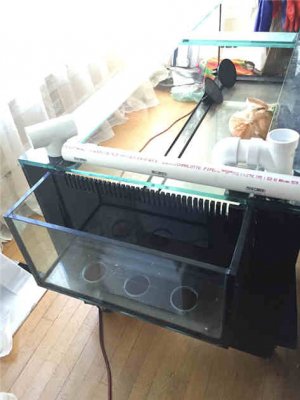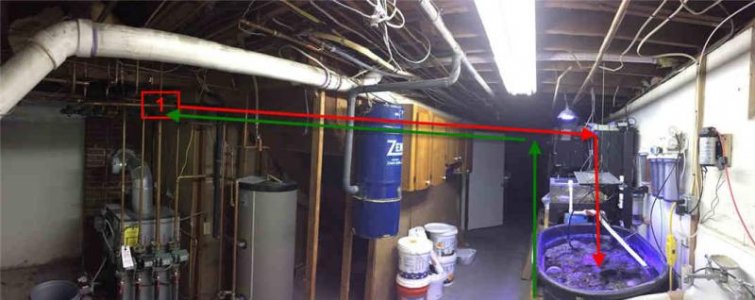uncleof6
Active member
The vinyl tubing is also 1" ID. (Of course it is restricted a tad by the smaller nipples that you clamp the tubing too.) The open channel seems to be hogging all the flow. On start up, even with the siphon channel valve completely closed, the water level never makes it down the emergency pipe before the open channel just starts draining the box like mad.
Sigh. I'm going to have to replumb this aren't I?
There is a very short list of possibilities for the cause of your issue.
1) Your pipes are too deep in the sump. They need to be less than 1" below the surface of the sump. Any more than that creates the need for greater head pressure to purge the air out of the siphon line.
2) The air vent line is to low in the overflow box. If it is too low, the open channel will trip to siphon, before the siphon has a chance to purge the air. If the water level does not make it to the top of the dry emergency, there will not be enough head pressure to start the system, and hence the open channel takes all the flow. That is the acid test. The air vent line inlet needs to be above the inlet to the dry emergency,
3) Horizontal runs in the plumbing can cause the siphon to air lock, and the open channel takes all the flow.
3) Less common problem, is the bulkheads being too large for the flow rate. If you have 1.5" bulkheads, and 600gph (just a random low flow number) the system will not start, and the open channel takes all the flow.
4) Vinyl tubing is a poor material to use. The fittings are restrictive, just for one. If you need "flexibility" then spa-flex is the material to use. Quite honestly, there should be no need for flexibility, as a little thought can usually solve most routing problems.
Invariably, with start up issues, it is a problem with the implementation. How it was put together. Using a fine tooth comb, and going over the implementation, will solve the issue.
**********************************************************
Topic Change:
In this post http://reefcentral.com/forums/showpost.php?p=23863094&postcount=8530, (no reflection on the person that posted it) the dry emergency is way to low in relation to the other two standpipes, and the water level has no place to rise. It is a certain recipe for a failed system. I have stressed this in the past, but I will go back to it again: you cannot stuff this system in a tiny box, and expect it to work the way it is supposed to. It may drain water, but it will not work the way it is supposed to. I have run too many tests on "jamming" it in small boxes. This system functions on head pressure, not miracles, and the setup in the cited post, will not get any head pressure on the siphon.If you look back a ways in this thread, I posted a link to a video that shows how high the water level needs to get to start the siphon, the right way.
I am not enthralled with the internal/external concept, and I built it over 5 years ago. It works well, but was a waste of time. I don't think the "need for minimal footprint" should outweigh the need for performance, and the "small" internal/external setups (aka "ghost overflow") are self defeating, and a considerable step backwards, performance wise. What should come first is the needs of the system, not aesthetics; the "ghost overflow" is no more aesthetic than an original design BA, but from what I have seen, the original design BA out performs it.
Last edited:



